Utopia as a Safe Space
In the Utopia as a Safe Space module, we situate participants' attention to the world that unfolds behind the concepts of Utopia and Safe Space, exploring the unseen connections between these two concepts.



Utopia, a term introduced by Sir Thomas More in his 1516 book Utopia, etymologically refers to the idea of "no place" or "non-existent." It represents a society or community that has yet to be realized, a place in the process of emerging and not currently existing but fervently desired by individuals or groups.



Safe Spaces embody the intimate, often invisible connections we nurture in our everyday lives. These relationships, which we engage with regularly, offer us a profound sense of security and warmth. They can take various forms, including:
Locations: such as home, bars, or familiar hangout spots
Individuals: like family, friends, or partner
Objects or memories
Safe Spaces are both connections and places - sometimes unseen, sometimes concrete - that we hold dear and seek out for comfort.



In the Utopia as a Safe Space module, each student is encouraged to design their own utopian community - an ideal construct that crystallizes their deepest desires and fears -creating a space to explore the potential of a world that is both utopian and safe, thereby manifesting a future that has yet to come to fruition.


